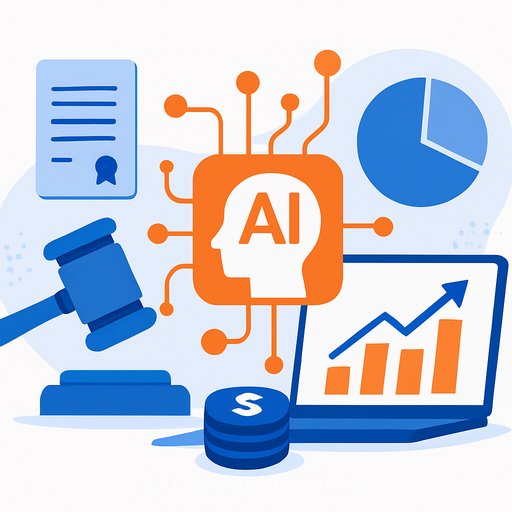AI Saves Time and Money. Here's How Legal Teams Avoid High-Stakes Fallout
AI is already trimming research hours, summarizing records, and drafting first-pass documents. The upside is real. The downside is liability, privilege issues, and regulatory heat if controls are sloppy.
This guide gives legal teams a practical playbook: what to permit, what to block, what to put in contracts, and how to prove diligence when clients, courts, or regulators ask hard questions.
What's Working Right Now
Legal teams are using AI for rapid case summaries, clause comparison, e-discovery triage, and admin automation. Results improve with tight prompts, approved data sources, and human review before anything leaves the building.
The biggest wins come from low-risk, internal workflows where accuracy is checked and no sensitive data is exposed to public tools.
The High-Stakes Risks You Need to Anticipate
- Confidentiality and privilege waiver through public tools or vendor logs
- Hallucinations that slip into filings, reports, or client work product
- Bias and discrimination in hiring, lending, housing, or benefits decisions
- IP questions on training data, output ownership, and right of publicity
- Vendor security gaps, data residency problems, and model retraining on your inputs
- Regulatory exposure across privacy, consumer protection, and sector rules
Data, Privilege, and Confidentiality
- Do not paste client-confidential or privileged content into public models. Use enterprise tools with data isolation and no-training guarantees.
- Turn off chat history and model training by default. Log and restrict who can change these settings.
- Redact identifiers before AI review. Keep originals in your DMS; route only redacted copies to AI.
- Confirm vendor data flow: storage location, encryption, retention, deletion windows, and subprocessors.
- Document privilege protocols. If AI touches privileged content, record the tool, model, settings, and reviewers.
Accuracy and Hallucinations
- Require human-in-the-loop review for any client-facing or court-facing output.
- Ban citations generated without source links. Verify every citation in the record.
- Use retrieval-augmented generation (RAG) tied to your approved knowledge base to reduce fabrication.
- Keep model and prompt versioning so you can reproduce outputs later.
Bias and Discrimination Controls
- If AI touches employment, credit, housing, health, or education, run and store bias tests on relevant protected attributes.
- Require vendor bias reports for high-impact use cases and define re-testing intervals.
- Provide clear human override paths and explainability on key decisions.
Map your approach to recognized guidance such as the NIST AI Risk Management Framework for defensibility. NIST AI RMF
IP: Training Data, Outputs, and Indemnities
- Training data: get written disclosure of sources, licenses, and any opt-out mechanisms. Note limits for cross-border use.
- Outputs: confirm ownership or license terms for generated content; address moral rights in relevant jurisdictions.
- Brand and publicity: restrict cloning of voices, likenesses, and styles without written consent.
- Indemnities: seek IP indemnity for third-party claims tied to model training or generated outputs, with defense and settlement control.
Contracts: Clauses That Save You Later
- Data processing addendum with audit rights, SOC 2/ISO evidence, and breach notice SLAs.
- No-training-on-customer-data clause and clear retention/deletion timelines.
- Subprocessor approval and data residency commitments.
- Model/version pinning and change-notice windows for material updates.
- Bias testing obligations for high-risk uses, plus reporting and remediation duties.
- Liability caps that exclude breaches, IP infringement, and willful misconduct.
Governance That Actually Works
- AI policy: approved tools, banned inputs, review standards, and disclosure rules.
- RACI: who approves use cases, who reviews prompts, who signs off on production rollout.
- AI register: each use case, purpose, data, model, owner, risk tier, and last review date.
- Tiered risk: low (internal drafts), medium (client drafts), high (automated decisions affecting rights or money).
- Training: short, role-based modules with real examples from your matters.
Litigation and eDiscovery Readiness
- Preserve prompts, context documents, model IDs, and timestamps for significant outputs.
- Flag where AI contributed to a document. Keep human review notes and corrections.
- Set a hold protocol for AI logs and vendor-held traces.
Regulatory Outlook
Expect more rules on transparency, high-risk use cases, and data controls. If you have EU exposure, track classification, documentation, and conformity needs under the EU approach to AI rules.
- Maintain technical folders: data sources, testing, monitoring, and incident records.
- Stand up an internal review board for high-impact deployments.
Reference point: the EU's legislative page for AI provides scope and obligations by use case. EU AI policy overview
Insurance, Ethics, and Client Communication
- Check malpractice coverage for AI-assisted work and automated decisions.
- Update engagement letters: AI use, confidentiality safeguards, and human review commitments.
- Disclose AI assistance where required by court rules or client policy. Keep it simple and factual.
30-Day Action Plan
- Week 1: Approve a shortlist of enterprise AI tools. Block public tools at the network level.
- Week 2: Publish a two-page AI policy. Train staff on banned inputs and review standards.
- Week 3: Add AI clauses to your standard vendor and client templates. Start an AI register.
- Week 4: Pilot two low-risk use cases with measurable time savings. Document results and refine.
Quick Checklist
- Data isolation and no-training guarantees
- Human review before anything client- or court-facing
- Bias testing for high-impact use cases
- IP ownership and indemnity clarity
- Contractual controls: DPA, audit, residency, versioning
- AI register, logs, and eDiscovery readiness
Keep Your Edge
Legal teams that move early set the rules instead of reacting to them. Start with contained use cases, write the guardrails, and keep evidence of your controls.
If your team needs practical upskilling on vetted tools and workflows, see our role-focused catalog: Complete AI Training - Courses by Job
Your membership also unlocks:






